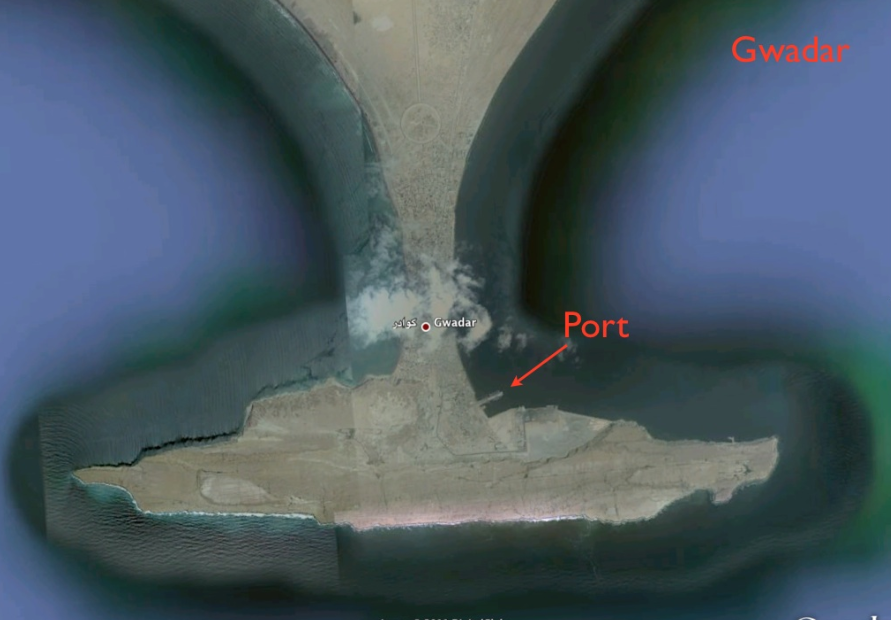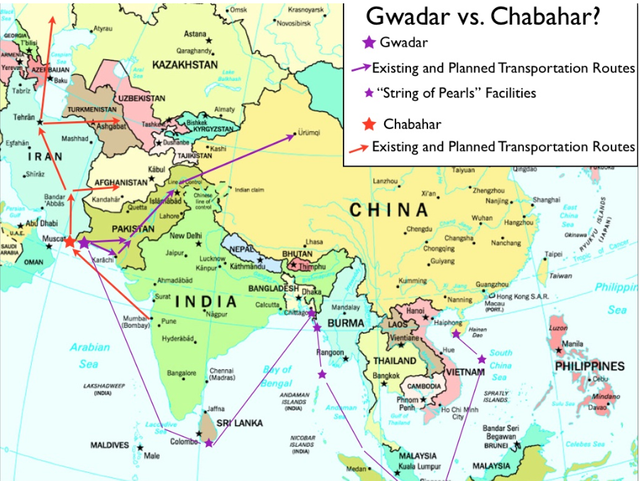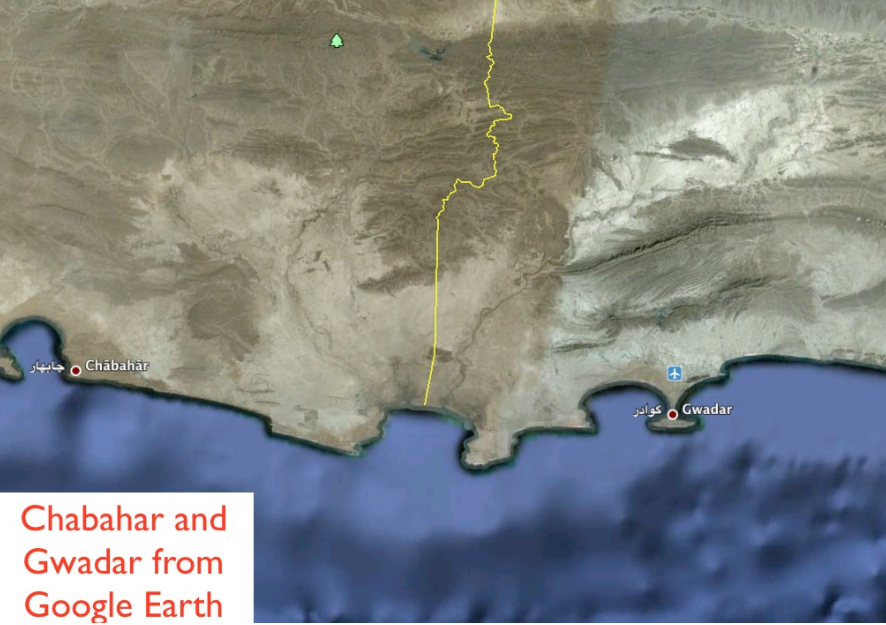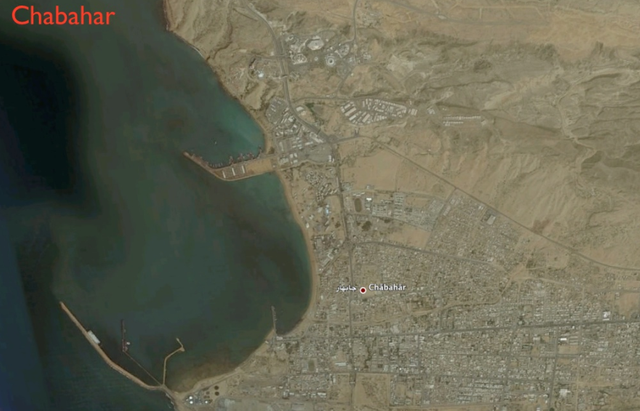

Pakistan has given China a base at Gwadar in the core of Baluch region. So an autonomous Baluchistan would serve U.S. key interests notwithstanding the prompt objective of countering Islamist powers.
Balochistan is a devastated locale ambushed by rebellion and ethnic strife. Be that as it may, it is rich in assets and it possesses an inexorably key geo-vital position. Subsequently, Balochistan has been the concentration of enormous infrastructural ventures. Iran and Pakistan are creating contending port, rail, and roadway systems, planning to pipe the exchange of Central Asia through their own national domains. As neither one of the countries can deal with the expenses and specialized difficulties all alone, both are banding together with different states; Pakistan has swung to China, and Iran to India. Thus, contention amongst Iran and Pakistan is mounting. Baloch extremists, as anyone might expect, have focused on the new undertakings, inciting military acceleration.
Google Earth Image of Gwadar, PakistanPakistan's primary activity in Balochistan starts at the port of Gwadar, not a long way from the Iranian fringe. Gwadar was a minor angling station on an inadequately settled drift through the vast majority of the twentieth century. In 1993, the Pakistani government chose it for port advancement, wanting to facilitate the blockage at Karachi and to tap the future exchange of Central Asia. Development, completed by China, started in 2002, and by 2008 the office was operational. Administration of the tax-exempt port is right now contracted out to PSA International, once in the past the Port of Singapore Authority.
As the harbor was going in, so too were transportation lines. Preceding the development of the Makran Coastal Highway (2002-2004), go amongst Gwadar and Karachi required a few days over harsh soil tracks; now it should be possible in six hours. Another new street joins Gwadar to northern Sindh, and 2007 saw the advancement of the New Gwadar International Airport. Different gets ready for Gwadar incorporate shipbuilding offices, flammable gas pipelines, and an army installation. As indicated by the official site, the port will "go about as an impetus for countless activities like: trans-shipment of mass load; oil stockpiling, refinery, and petrochemicals; send out preparing and mechanical zones; fare of minerals/domesticated animals; and administrations (inns, convenience, tourism)." In April 2011, Pakistan declared that it was consulting with China to interface Gwadar with the Pakistani rail organize, which would involve laying more than 900 kilometers of track. Around the same time, general Ashfaq Kayani declared plans to build up a military foundation of innovation in the city.
China's association with the task broadens well past development and financing. The Chinese government predicts Gwadar as the end of a "secondary passage" transportation hall into western China. A proposed pipeline would convey unrefined petroleum from the port to Xinjiang, improving Chinese vitality security. A few US security examiners guarantee that China will likewise utilize Gwadar for military purposes, some portion of its "pearl necklace" procedure intended to extend control into the Indian Ocean and secure access to key Middle Eastern and African assets. China denies military aspirations, asserting that it looks for an "agreeable sea." The United States and India are not persuaded that Chinese outlines are completely quiet. It has in this way been proposed—outstandingly by the Heritage Foundation—that the two nations should produce an organization together to offset China in the area. Such an association may yet emerge, however it faces a colossal snag in Iran. New Delhi is as of now teaming up with Tehran on a contending port, found just forty-seven miles (seventy-five kilometers) from Gwadar.

Google Earth Image of Gwadar and ChabaharThe Iranian port of Chabahar was additionally a moderately residential area before it was chosen for infrastructural advancement. The underlying plans were incubated under the shah, with assistance from the United States. The Iranian insurgency of 1979 put the venture on hold, however it was resuscitated amid the Iran-Iraq war, when transporting through the Strait of Hormuz was occasionally incapacitated. Wanting to kick off its economy, Iran made the Chabahar Free-Trade Industrial Zone in 1992. Chabahar is currently slated to end up plainly a vacationer goal and a focal point of advanced education. The International University of Chabahar, set up in 2002, offers designing, business, and software engineering degrees, as a team with the University of London and the London School of Economics.
Iran has been extending Chabahar's port offices with expectations of catching a portion of the anticipated Central Asian exchange that would some way or another be piped through Gwadar. India has marked on, helping redesign the port and building new street and rail linkages. The arrangement is to associate Chabahar to Afghanistan, previous Soviet Central Asia, and Russia; eventually a "multi-modular transport interface" should achieve St. Petersburg. Iran and India are likewise talking about a conceivable flammable gas pipeline that would wind along the seabed from Chabahar to India, by-passing Pakistan.

Google Earth Image of ChabaharProgress on the Chabahar port has been slower than arranged. As indicated by a March 2011 Reuters report, "Indian authorities now trust that Iranian hesitance to move quicker on Chabahar might be connected to its tensions about the disturbed Sistan-Baluchestan area where Shi'ite Muslim Iran is attempting to put down a Sunni Muslim revolt." India needs to speed up the task, as it is edgy to get a secondary passage passageway into Afghanistan that keeps away from Pakistan. India has as of now, at awesome cost and threat, fabricated the 218-kilometer Zaranj-Delaram interstate in Afghanistan, which it would like to associate with the new port.
The geopolitical and financial interest presently in progress in Baluchistan fits into what is some of the time called the "New Great Game" (the first having been the nineteenth century challenge between the British and Russian realms for impact in a similar locale). As some time recently, the geopolitical contemplations can be mind boggling. As indicated by the Wikipedia, the New Great Game includes "rivalry between the United States, the United Kingdom and other NATO nations against Russia, the People's Republic of China and other Shanghai Cooperation Organization nations for 'impact, power, administration and benefits in Central Asia and the Transcaucasus.'"
The Wikipedia's delineation of the New Great Game does not coordinate the opposition being pursued amongst Gwadar and Chabahar. The Shanghai Cooperation Organization isn't a genuine partnership, and its two biggest individuals, Russia and China, wind up on inverse sides of this specific contention. It is likewise sketchy where the United States and whatever is left of NATO figure in. In spite of its (fraying) union with Islamabad, the US is barred from the Pakistan-China linkage, and regardless of its advancing ties with New Delhi, it is rejected from any nexus that includes Iran. What's more, in spite of Selig Harrison's affectionate wants, it is exceedingly improbable that the United States will have the capacity to join forces with an autonomous Balochistan at any point in the near future. The US and NATO, doubtlessly, are sitting out this round of the New Great Game.
Congratulations @bakhtiarzehri! You have completed some achievement on Steemit and have been rewarded with new badge(s) :
Click on any badge to view your own Board of Honor on SteemitBoard.
For more information about SteemitBoard, click here
If you no longer want to receive notifications, reply to this comment with the word
STOPDownvoting a post can decrease pending rewards and make it less visible. Common reasons:
Submit